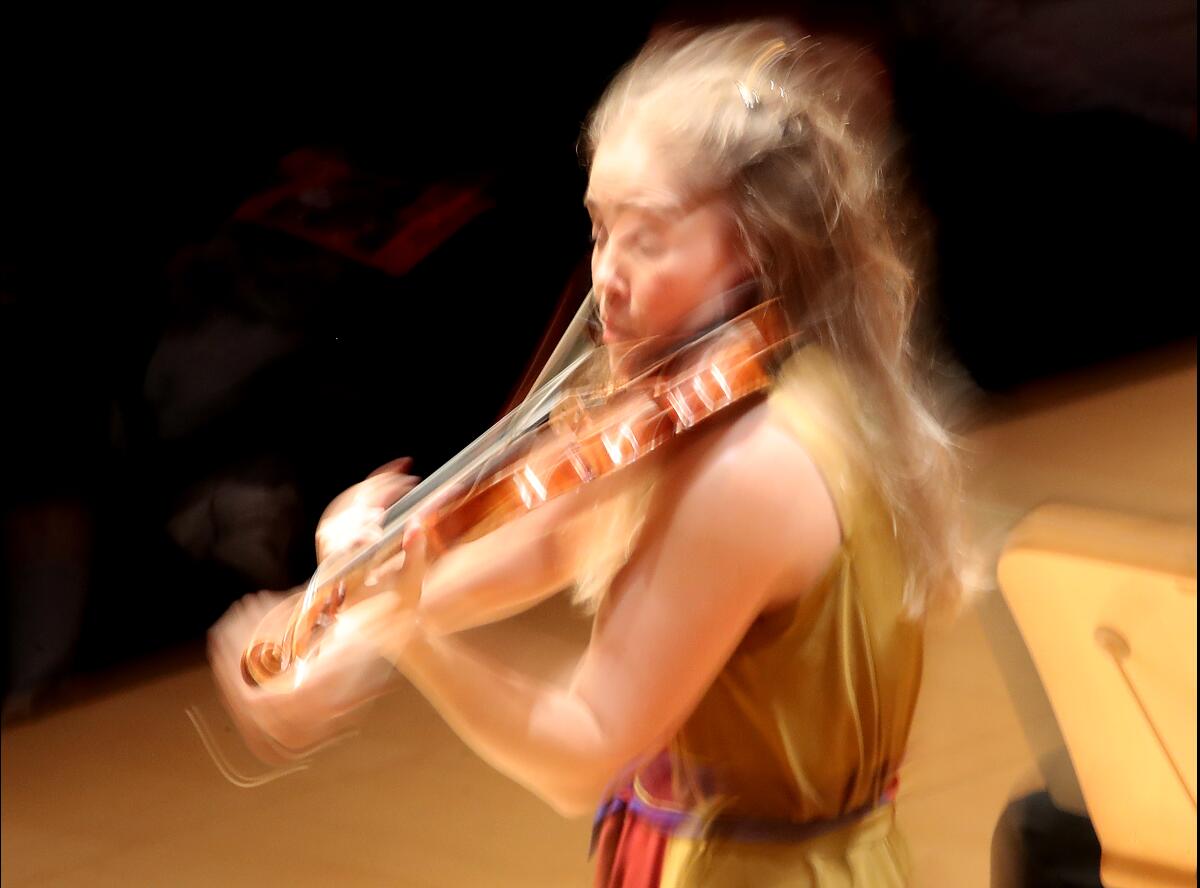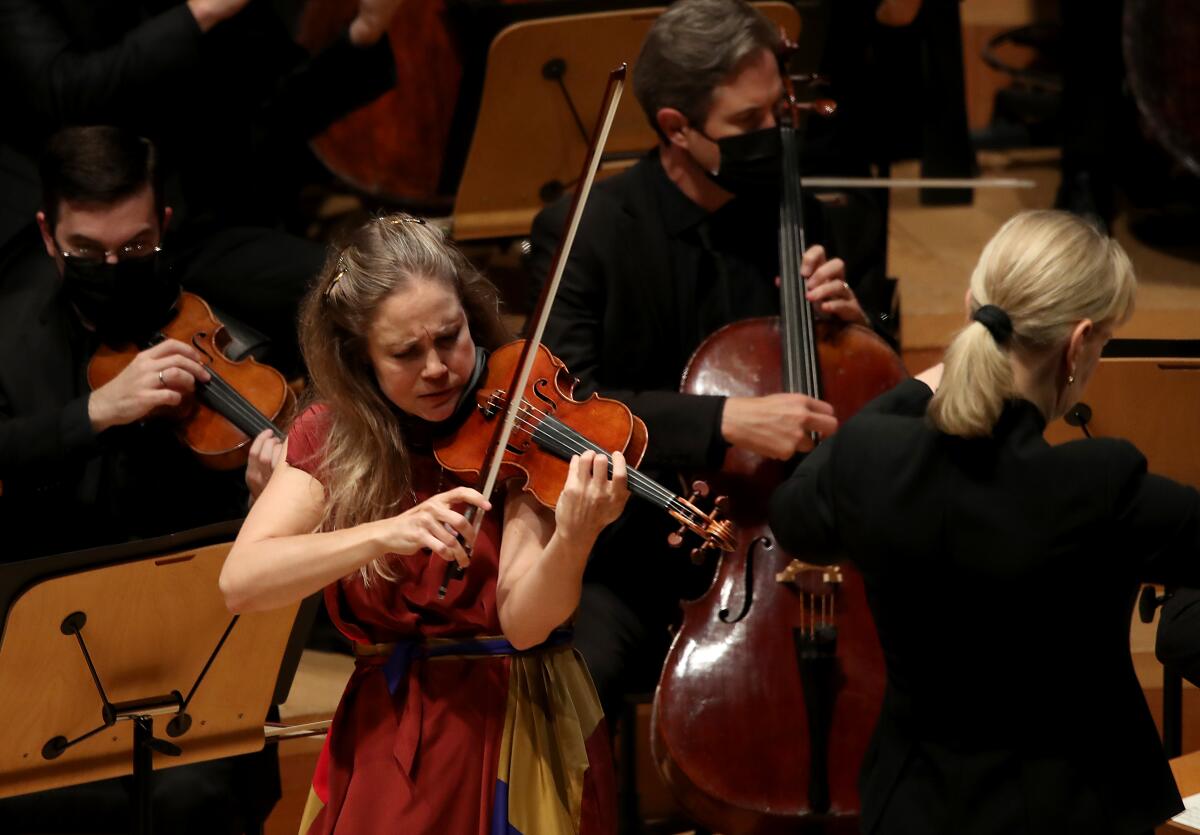Review: With Susanna Mälkki and Leila Josefowicz at the helm, John Adams’ Violin Concerto soars

- Share via
On Sunday afternoon, principal guest conductor Susanna Mälkki began her last concert of the season with the Los Angeles Philharmonic with Steve Reich’s “Runner.” Thanks to the L.A. Marathon, it was a day of runners. Reich, though, is not one of them.
In a video discussing his 2016 piece for winds, percussion and strings, the composer, who turned 85 last month, said his exercise choice is the treadmill and bicycle; the title came to him out of nowhere. Reich resisted the name at first. But it stuck because of the performers’ need for pacing in the roughly 15-minute score. Not that this unparalleled master of pulse has ever written a piece that doesn’t need serious pacing — the astonishing rhythmic intricacies in Reich’s music require spectacular counting.
I don’t seem to be such a hot runner either. Stuck in marathon-triggered traffic, I arrived at Walt Disney Concert Hall seemingly just in time. But I lost the race by seconds, reaching the door to my aisle just as it closed.
There were compensations. For one thing, Nonesuch Records recorded the weekend’s two performances for an album scheduled for release in spring 2022. Another was the fascination of watching “Runner” on the lobby monitor while hearing the sound of the orchestra bleeding through the hall’s closed doors and mixing in with more distant sounds of traffic outside.
I know “Runner” through broadcasts of its first performances in Europe (premiering as the score for a dance choreographed by Wayne McGregor for the Royal Ballet). But in this case, not being able to hear the details very well made the push-pull of modulating meters and tempos a physical sensation that overpowered the aural one, like runners more attuned to their heartbeats than the ambient sounds around them (other than maybe rhythmic cheering). Funnily enough, after having run up the stairs and heard it this way, “Runner” indeed became more about running than passively listening, at least without the dance component.
Coronavirus may have silenced our symphony halls, taking away the essential communal experience of the concert as we know it, but The Times invites you to join us on a different kind of shared journey: a new series on listening.
Still, there was never any doubt that John Adams’ Violin Concerto with Leila Josefowicz as soloist was the main attraction. The concerto, which proved an instant sensation at its premiere in 1994 in Minneapolis and reached the L.A. Phil three years later, is already a modern classic widely performed.
Moreover, hardly a year has gone by during the last three decades when the orchestra hasn’t programmed something by Adams, who has been the L.A. Phil creative chair since 2009. For her part, Josefowicz has played Adams’ concerto well over 100 times and has recorded it. Josefowicz, a MacArthur Fellow, has absorbed it like no other violinist. As a longtime member of the L.A. Phil extended family, she is the inevitable go-to violinist when the orchestra is in need of a daring, probing, thinking, dancing, spectacularly virtuosic soloist. Composers including Adams (in his latest epic concerto, “Scheherazade.2”), Esa-Pekka Salonen, Kaija Saariaho and many others jockey to write for her.
However many times the violinist has played Adams’ concerto (lived the concerto is maybe more accurate) and some of us may have heard it, Sunday’s performance proved newly revelatory. In the long-limbed first movement, the solo violin traces one idea after another (Adams once compared this to Indian raga) in an ever-evolving, never-ending melody. Its unpredictability can make it hard to follow no matter how many times you’ve heard it, but Josefowicz made it easy. She played each turn of phrase, each gesture, as though it were a new thought or feeling that suddenly astonished her.
During the slow movement, titled “Body Through Which the Dream Flows,” the orchestra intoned a Pachelbel-like canon while the violin glided above in otherworldly melody. It seemed worth glancing at Josefowicz’s feet from time to time to see if they were maybe hovering a few inches off the ground. On the other hand, if you closed your eyes, it became hard to pinpoint where the disembodied voice of the violin was coming from.
Back on earth, the violinist transformed into a still ecstatic but now intemperate rocker in the electrifying last movement. Josefowicz isn’t exactly a runner either. Instead, her virtuosity surfs waves of jubilant energy. This time I found myself looking at the orchestra to see how in the world those players could stay properly seated.

Mälkki kept them grounded, though the orchestra accompaniment has its own many issues. Instrumental lines snake over bar lines, intersecting in convoluted ways. These instrumental colors are seldom stable, the combinations ever changing. Two vintage synthesizers from the early ’90s added an electronic glaze that was best kept subtle. But the conductor played a crucial part, maintaining a solid base that allowed the soloist her exceptional openness. Was this what it was like for earlier generations hearing Jascha Heifetz in his prime play the Tchaikovsky concerto? Probably.
Like Adams’ Violin Concerto, the L.A. Phil played Rachmaninoff’s “Symphonic Dances,” his last major piece, three years after it was written. (Rachmaninoff died at 70 shortly afterward, in 1943.) Few think of him as having been an L.A. composer, or the Symphonic Variations an L.A. piece. He lived here only a short time, and his name is usually an afterthought in any discussion of L.A. emigres in the first half of the 20th century. He was not a game-changing progressive as Schoenberg and Stravinsky were in this city.
But there was reason to think of Rachmaninoff that way Sunday. A grand boldness solemnized Mälkki’s performances of Russian scores by Tchaikovsky and Scriabin with the L.A. Phil the week before, and it did so even more this time with Rachmaninoff. A modernist at heart, Mälkki goes after the loudest, most attention-getting thunder the timpani can deliver. She commands crisp, transparent textures. She discovers in Rachmaninoff an essential rhythmic drive nearly comparable to that of Stravinsky or Bartók. In this performance she revealed the lyric, melancholic, ever-so-Russian saxophone solo in the first movement of the Variations to be unsentimental, ever-so-not-Russian and sonically clear as spring water. She revitalized a Russian romantic, now a revolutionary.
This is a difficult year, of course, with all planning necessarily last-minute for the L.A. Phil. A Mälkki marathon was hardly an option. Even so, a mere two weeks in the season for her are too few.
More to Read
The biggest entertainment stories
Get our big stories about Hollywood, film, television, music, arts, culture and more right in your inbox as soon as they publish.
You may occasionally receive promotional content from the Los Angeles Times.












